K. A. Wise
Graduate Research Assistant
University of Georgia
Department of Plant Pathology
D. S. Mueller
Iowa State University
Department of Plant Pathology
J. W. Buck
Assistant Professor
University of Georgia
Department of Plant Pathology
Georgia Station, Griffin, GA 30223
Email: jbuck@griffin.uga.edu
Wise, K.A., Mueller, D.S. and Buck, J.W. 2004. Quarantines and Ornamental Rusts. APSnet Features. Online. doi:10.1094/APSnetFeature-2004-0204

Introduction
The production of ornamental plants, including both nursery and floriculture crops, is a thriving and quickly expanding industry. Over a six-year span, the value of this industry in the United States increased over 23% to $14.3 billion in 2002 (12,33). Ornamental plant production is also a major industry in Australia, Canada, Europe, and South America. The U.S. Department of Agriculture (USDA) recognizes deciduous and evergreen trees, woody ornamental plants, and shrubs as nursery crops, while floriculture crops include foliage plants, cut flowers, flowering potted plants, and bedding plants (30,31). The wholesale value of the entire floriculture crop in 2002 was estimated to be worth $4.8 billion. California and Florida lead the nation in floriculture crop production ($1.8 billion in 2002), and combined these two states produce almost 40% of total U.S. wholesale floriculture sales (32).
Many floriculture crops are produced in the U.S. including geranium (Pelargonium xhortorum), chrysanthemum (Dendranthema morifolium), gladiolus (Gladiolus spp.), and daylily (Hemerocallis spp.). The value of the U.S. wholesale potted geranium crop from cuttings and seeds was $150 million in 2002 (32). Geraniums also have a substantial market as flowering hanging baskets and potted flowering plants. The U.S. wholesale crop of chrysanthemum was valued at $103 million for potted flowering bedding plants and $77 million for potted flowering foliage plants in 2001 (32). Gladiolus production for cut flowers in the U.S. in 2001 totaled $24.2 million (32). Daylilies are popular landscape plants that along with other herbaceous perennials were valued at $571 million in 2002 (32).
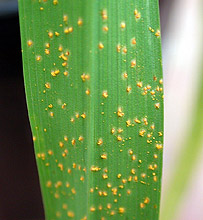
Fig. 1. Sporulating lesions (pustules) of daylily rust. These spores are characteristic signs used to diagnose rust infections. (Photo by D. S. Mueller). |
|
One serious disease that can negatively affect production of many ornamental crops is a fungal infection called rust. Infected plants develop lesions (pustules) on the lower surfaces of plant leaves which increase in size and eventually rupture the epidermis and release spores. These spores are typically brightly colored and are characteristic in diagnosing rust infections (Fig. 1). Pustules also can be present on the upper surface of leaves and can coalesce to form large necrotic areas (Fig. 2). Severe infections can result in premature leaf drop. Rust pustules also can form on stems and scapes, if present (Fig. 3). Rust spores are carried easily on wind currents and also can be disseminated by water splash, but long-distance dispersal of rusts on ornamental plants is mainly attributed to the movement of infected plants. Rust fungi typically have complex lifecycles involving one (autoecious) or two (heteroecious) hosts. Over 125 species of fungi that cause rust have been reported on 56 different ornamental crops (4). Examples of some of these rusts are presented in Table 1.
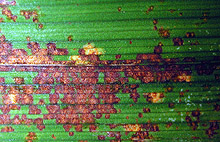 |
|
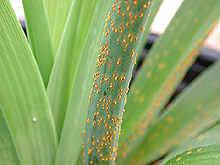 |
|
Fig. 2. Coalescing lesions of daylily rust. (Photo by D. S. Mueller). |
|
Fig. 3. Daylily rust pustules infecting the scape of the plant. (Photo by D. S. Mueller). |
Table 1. Selected ornamental rusts directly or indirectly affecting U.S. production.
| Host Plant |
Fungus |
Geographical
Distribution |
Reference |
Carnation (Dianthus
caryophyllus) |
Uromyces dianthi |
Worldwide |
7 |
China Aster
(Callistephus chinensis) |
Coleosporium asterum |
Canada,
England, and
northwest U.S. |
24 |
Chrysanthemum
(Dendranthema
xmorifolium) |
Puccinia chrysanthemi |
Australia,
England,
and U.S. |
3,16,36 |
| P. horiana |
Daisy
(Bellis perennis) |
P. obscura |
California,
England |
14,23 |
| P. laegenophora |
| P. distincta |
Daylily
(Hemerocallis spp.) |
P. hemerocallidis |
Costa Rica,
U.S. |
37 |
Geranium
(Pelargonia xhortorum) |
P. pelargonii-zonalis |
England,
South Africa
and U.S. |
8 |
Gladiolus
(Gladiolus spp.) |
U. transversalis |
Australia,
Europe,
South Africa |
2,6 |
Snapdragon
(Antirrhinum spp.) |
P. antirrhini |
England, U.S. |
4 |
Integrated management practices, including scouting, proper sanitation, use of resistant varieties (if available), and preventative fungicide applications, are used to manage rust outbreaks in floriculture crops and minimize potential disease losses (4,13). Several chemical classes of fungicides are registered for and have efficacy against rusts on ornamental crops. These include the strobilurins (e.g., azoxystrobin), sterol biosynthesis inhibitors (e.g., myclobutanil, propiconazole), and broad-spectrum protectants (e.g., chlorothalonil, mancozeb) (10).
Rusts have the potential to dramatically affect floriculture production because these pathogens cannot be adequately detected on symptomless but contaminated or infested propagation material entering the U.S. or moving state-to-state. For example, quiescent rust spores can easily lodge in the crown of plants that have had foliage removed for shipping purposes (Fig. 4). Symptomless plants then can be moved long distances through international or interstate trade, dispersing the pathogen and introducing it into areas that were previously pathogen-free (28). Rust fungi are obligate parasites that do not usually kill infected plants. However, infection by rusts will reduce plant health and vigor, reduce flower production, and decrease the aesthetic value of ornamental crops due to the presence of pustules. Also, quarantine restrictions and eradication efforts can be costly and have a significant economic impact on floriculture production.
| |
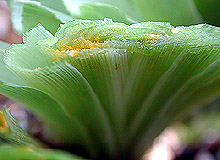
Fig. 4. Rust spores resting between leaves in the crown of a plant that has been cut back. (Photo by D.S. Mueller) |
|
Plant Quarantines
Plant quarantines can be used to restrict the movement of plants into the U.S. and to limit state-to-state movement of plants. Regulatory control of ornamental plants was recently reviewed by Stebbins and Johnson (28). The first federal regulatory act designed to control the introduction of foreign pests into the U.S. was passed into law in 1912. This law, called the Plant Quarantine Act, and ensuing regulations help prevent or delay the introduction of foreign pathogens, including rusts, into the U.S. Rust pathogens of ornamental crops that are currently on the Plant Protection and Quarantine (PPQ) Regulated Pest List are found in Table 2. Quarantines have been used to limit movement of rust pathogens of geranium, chrysanthemum, daylily and gladiolus into the United States. A complete list of plant pathogens regulated by the U.S. Animal and Plant Health Inspection Service (APHIS) can be found at the USDA APHIS web page.
Table 2. Causal agent and common disease name of ornamental
crops regulated by USDA APHIS PPQ in 2004a.
| Scientific Name |
Common Name |
| Chrysomyxa ledi |
Rhododendron-spruce needle rustb |
| Puccinia gladioli |
Gladiolus rust |
| Puccinia horiana |
Chrysanthemum white rust |
| Puccinia mccleanii |
Gladiolus rust |
| Uredo gladioli-buettneri |
Graminicolous rust |
| Uromyces gladioli |
Gladiolus rust |
| Uromyces nyikensis |
Gladiolus rust |
| Uromyces transversalis |
Gladiolus rust |
a Obtained from PPQ Regulated Plant List.
b Listed as Chrysomyxa leaf rust on the American Phytopathological
Society list of common names of plant diseases.
Examples of Quarantines Proven Effective in the U.S.
1. Chrysanthemum white rust. Chrysanthemum white rust, caused by the fungus Puccinia horiana, is presently classified as a quarantine significant pathogen in the U.S. (Table 2) and Australia. This rust has been described as the most serious disease of greenhouse- produced chrysanthemums because infected plants are unmarketable resulting in large economic losses (15,21,22,25). Puccinia horiana is an autoecious rust pathogen that is native to Asia. Infections are characterized by yellow lesions on the upper leaf surface that become necrotic. White pustules, which produce teliospores and basidiospores under favorable environmental conditions, develop on the lower leaf surface (1).
Chrysanthemum white rust was introduced into England from Japan in 1963 (36). For more than twenty years an eradication campaign and quarantine measures were in place to prevent movement of the pathogen. These measures were ultimately unsuccessful and in 1989 the quarantine was lifted. Chrysanthemum white rust is now endemic in England (36). The rust has also become endemic in the Netherlands, which exports almost half of their chrysanthemum cuttings and flowers (25). Colombia, which is the second largest flower exporter behind the Netherlands, sends 97% of its total chrysanthemum exports to the U.S. (22). White rust has been present in Colombia since the late 1980s and eradication efforts have been in place to remove the pathogen from export producing areas. If white rust were to be detected on imported plant material from Colombia, all U.S. imports would be stopped, resulting in enormous financial losses for Columbian producers and U.S. distributors. A strict eradication and control campaign has been implemented in Columbia to keep all chrysanthemum exports free of P. horiana (22). This campaign has been funded by emergency funds obtained from Colombian growers and financial backing from the flower industry (22).
Isolated outbreaks of white rust have occurred in the 1990s in New Jersey, Pennsylvania, Washington, and Oregon (1,3). The discovery of white rust on chrysanthemum plants in production areas of California in 1992 prompted a reevaluation of the eradication program in place for control of the disease (3). Weekly sprays of triazole or strobilurin fungicides such as azoxystrobin, hexaconazole, myclobutanil, and propiconazole were found to be suitable regulatory treatments for exclusion and eradication of this pathogen (3,15,19). However, in 2001 isolates of white rust insensitive to both the triazole and strobilurin classes of chemicals were found in England (5). Outbreaks of white rust in the U.S. have been limited, and the quarantine is still deemed effective (1,3).
2. Gladiolus rust. Six gladiolus rust pathogens (Puccinia gladioli, P. mccleanii, Uredo gladioli-buettneri, Uromyces gladioli, Uromyces nyikensis, Uromyces transversalis) are listed as quarantine significant pathogens by the PPQ (Table 2). Transverse leaf rust (Uromyces transversalis) is an autoecious rust pathogen native to South Africa. The fungus spread into production areas of Europe and South America in the late 1960s (17) and into Australia in the 1990s (2). The rust is characterized by orange pustules that form on the leaf surface. Pustules can also form on the inflorescence and flower spike of the plant. The disease has resulted in 100% losses and has made production of gladiolus for cut flowers almost impossible without fungicide use in parts of Africa (6).
Examples of Quarantines Proven Ineffective in the U.S.
1. Daylily rust. Daylily rust caused by Puccinia hemerocallidis is a heteroecious rust native to Southeast Asia. The alternate host is the herbaceous perennial Patrinia (20). Yellow pustules form on leaf surfaces (Fig. 1). These pustules produce urediniospores that can continually re-infect the host and spread to other daylilies. The pathogen was first detected in Florida and Georgia production areas in 2000 (38) and later identified as P. hemerocallidis (9). Although it is suspected that the infected plants came from Central America, the original source of the inoculum has not been pinpointed (37,38). By fall of 2001, the rust was present in over 24 states within the U.S. and Costa Rica (9,35). The pathogen was officially quarantined, and plant movement was regulated in the U.S. in 2001 (35). In 2002, daylily rust was recognized as endemic in the southeastern U.S. Containment of the pathogen in the U.S. was deemed unrealistic due to widespread movement of plants by hobbyists and nurseries and the USDA PPQ lifted the federal quarantine in January 2002.
2. Geranium rust. Geranium rust caused by Puccinia pelargonii-zonalis infects the zonal geraniums (Pelargonium xhortorum) (26). Puccinia pelargonii-zonalis is an autoecious rust pathogen that produces dark brown urediniospores on the lower surfaces of the leaves and chlorotic halos on the upper leaf surface (8). As lesions age, concentric rings of urediniospores are produced (Fig. 5). The pathogen was introduced into Europe from South Africa in the early 1960s and by 1967 it had been introduced into greenhouses in California, New York, and Canada (18). Despite quarantine restrictions and the destruction of infected plants, the rust became endemic in Europe and California by the 1970s (27). The constant re-introductions of the pathogen into production areas led to the lifting of most quarantines in the early 1980s (29). In 1997, an epidemic of this rust negatively impacted commercial geranium production in the southeastern U.S. (11).
| |
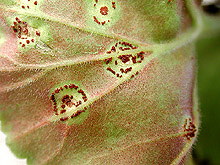
Fig. 5. Sporulating lesions of geranium rust. As the infection progresses, concentric rings of pustules erupt around the initial infection point. (Photo by D. S. Mueller). |
|
Why Do Quarantines Fail?
Many factors can contribute to the introduction of rust-infected stock into commercial production areas. International trade of ornamental crops has made the exclusion of rust pathogens difficult because contaminated plant parts may be symptomless and inadvertently allowed to enter quarantined areas. With repeated introductions pathogens may become endemic causing the quarantine to fail. The inability to adequately detect rust pathogens on contaminated or infected propagation materials severely hinders quarantine efforts. While rusts can be easily diagnosed when sporulating lesions are present, young non-sporulating lesions are often small and may remain undetected if only a few pustules are present in a shipment of tens of thousands of plants. Improved detection methods are needed to more accurately diagnose infections. New diagnostic methods and keys are being developed to more quickly and accurately identify quarantined pathogens (34). The effective implementation of these techniques must be the next step in quarantine enforcement.
Quarantines may also fail when rust-infected crops are unregulated. For example, daylily hobbyists and hybridizers can trade and sell plants in federally unregulated markets, such as farmers’ markets and trade shows. This compromises the effectiveness of quarantines and was one of the reasons for lifting the daylily rust quarantine in 2002 (35). Some of the isolated outbreaks of chrysanthemum white rust in North America also were attributed to hobbyists bypassing inspectors when transporting cuttings (1). To ensure the effectiveness of quarantines, the information exchange between federal agencies and hobbyists should be improved to better inform growers of the potential implications of moving infected plants.
New fungicidal developments in the 1980s and 1990s, led to fungicides such as myclobutanil and azoxystrobin that have eradicant or curative activity for some rust fungi (3,5). This technology can ease the pressure on quarantine restrictions, because the fungus can theoretically be eradicated from diseased shipments, allowing trade to continue. The chrysanthemum white rust quarantine and eradication campaign in England was ended in 1989, after propiconazole was proven to be effective at eradicating the pathogen (36). However, the reliance on chemical controls as the sole means of managing white rust contributed to the development of fungicide resistance in P. horiana (5). Additional research is needed to determine if different fungicides display curative activity against a variety of rust pathogens, and to develop treatments that kill quiescent spores on plant foliage. Adopting sound disease management practices, whether rusts are endemic or not, will help prevent future outbreaks and minimize existing problems.
Additional Resources
Chrysanthemum White Rust from the Canadian Ministry of Agriculture, Food, and Fisheries
Daylily Rust Information Page
Daylily Rust Pest Alert from the National Plant Board
USDA APHIS PPQ Safeguarding Study
Literature Cited
1. Anonymous. 1988. Chrysanthemum white rust. Yoder Brothers Inc. Barberton, OH.
2. Beilharz, V., Parbery, D. G., and Pascoe, I. G. 2001. Gladiolus rust (caused by Uromyces transversalis) in eastern Australia. Aust. Plant Pathol. 30:267-270.
3. Bonde, M. R., and Rizvi, S. A. 1995. Myclobutanil as a curative agent for chrysanthemum white rust. Plant Dis. 79:500-505.
4. Chase, A. 2002. Controlling rust diseases. Chase News 1:1-6.
5. Cook, R. T. A. 2001. First report in England of changes in the susceptibility of Puccinia horiana, the cause of chrysanthemum white rust, to triazole and strobilurin fungicides. Plant Pathol. 50:792.
6. Ferreira, J. F., and Nevill, W. G. 1989. Evaluation of bitertanol and triadimefon for the control of gladiolus rust caused by Uromyces transversalis. Plant Dis. 73:987-990.
7. Ferrin, D. M., and Rohde, R. G. 1991. Tests compare fungicides for control of rust on green-house carnations. Cal. Ag. 45:16-17.
8. Harwood, C. A., and Raabe, R. D. 1978. The disease cycle and control of geranium rust. Phytopathology 69:923-927
9. Hernandez, J. R., Palm, M. E., and Castlebury, L. A. 2002. Puccinia hemerocallidis, cause of daylily rust, a newly introduced disease in the Americas. Plant Dis. 86:1194-1198.
10. Jeffers, S. N., Miller, R. W., and Powell, C. C. 2001. Fungicides for ornamental crops in the nursery. Pages 409-416 in: Diseases of Woody Ornamentals and Trees in Nurseries. R. K. Jones and D. M. Benson, eds. American Phytopathological Society, St. Paul, MN.
11. Jeffers, S. N. 1998. Geranium rust: A potentially serious threat to the zonal geranium industry. Greenhouse Product News 8:20-23.
12. Jerardo, A. 2003. Floriculture and Nursery Crops Outlook. USDA Economic Research Service. FLO-02.
13. Jones, R. K., Simone, G. W., von Broembson, S. L., and Dutky, E. 2001. Integrated Disease Management. Pages 376-383 in: Diseases of Woody Ornamentals and Trees in Nurseries. R. K. Jones and D. M. Benson, eds. American Phytopathological Society, St. Paul, MN.
14. Koike, S. T., and Scholler, M. 2001. First occurrence of a rust fungus on English daisy (Bellis Perennis) in North America. Plant Dis. 85:562.
15. Lam, C. H., and Lim, T. K. 1993. Efficacy of hexaconazole for the control of white rust on chrysanthemum and powdery mildew on roses. Int. J. Pest Management 39:156-160.
16. Lambe, R. C. Chrysanthemum rust. 1970. Vir, Polytech. Inst. Plant Dis. Contr. Notes Ext. Div. Contr. Series 108.
17. Littlejohn, G. M., and Blomerus, L. M. 1997. Studies on Gladiolus resistance to transverse rust. Acta Hort. 430:509-516.
18. Nichols, L. P., and Forer, L. B. 1972. Geranium rust discovered in Pennsylvania. Plant Dis. 56:759.
19. O’Neill, T. M., and Pye, D. 1997. Evaluation of fungicides for control of chrysanthemum white rust. Ann. Appl. Biol. Suppl. 130:8-9.
20. Ono, Y. 2003. Does Puccinia hemerocallidis regularly host-alternate between Hemerocallis and Patrinia plants in Japan? J. Gen. Plant Pathol. 69:240-243.
21. Orlikowski, L. B., and Wojdyla, A. 1982. Chemical control of chrysanthemum white rust Puccinia horiana. Acta Hort. 125:201-206.
22. Ortega, L. 1999. Prevention and eradication of white rust (Puccinia horiana) in Colombia. Acta Hort. 482:187-195.
23. Preece, T. F., Weber, R. W. S., and Webster, J. 2000. Origin and spread of the daisy rust epidemic in Britain caused by Puccinia distincta. Mycol. Res. 104:576-580.
24. Raabe, R. D., and Pyeatt, L. 1990. Control of rust of china aster and comments on the name of the pathogen. J. Environ. Hort. 8:89-92.
25. Rattink, H., Zamorski, Cz., and Dil, M. C. 1985. Spread and control of chrysanthemum white rust (Puccinia horiana) on chrysanthemums on artificial substrate. Med. Fac. Landbouww. Rijksuniv. Gent 50:1243-1249.
26. Rytter, J. L. 1993. Rust. Pages 230-232 in: Geraniums IV. J. W. White, ed. Ball Publishing, Batavia, IL.
27. Rytter, J. L., Lukezic, F. L., Craig, R., and Moorman, G. W. 1989. Biological control of geranium rust by Bacillus subtilis. Phytopathology 79:367-370.
28. Stebbins, T., and Johnson, D. 2001. Regulatory control. Pages 457-458 in: Diseases of Woody Ornamentals and Trees in Nurseries. R. K. Jones and D. M. Benson, eds. American Phytopathological Society, St. Paul, MN.
29. Stephens, C. T. 1981. Geranium rust. Univ. Missouri Ext. Bull. E-1493.
30. USDA National Agricultural Statistics Service. 2001. Nursery crops 2000 summary.
31. USDA Agricultural Statistics. 2003. Fruits, trees, nuts and horticultural specialties.
32. USDA National Agricultural Statistics Service. 2003. Floriculture crops 2002 summary.
33. USDA Economics and Statistics System. 1997. Floriculture and environmental horticulture yearbook. FLO-1997.
34. USDA. 1999. Animal and Plant Health Inspection Service Plant Protection and Quarantine Risk Assessment Safeguarding Study.
35. US National Plant Board. 2001. Daylily rust pest alert. U. S. Animal and Plant Health Inspection Services.
36. Whipps, J. M. 1993. A review of white rust (Puccinia horiana Henn.) disease on chrysanthemum and the potential for its biological control with Verticillium lecanii (Zimm.) Viegas. Ann. Appl. Biol. 122:173-187.
37. Williams-Woodward, J. L., and Buck, J. W. 2001. Daylily rust caused by Puccinia hemerocallidis: A new disease on daylily in the U.S. Proc. South. Nursery Assoc. Res. Conf. 46:234-236.
38. Williams-Woodward, J. L., Hennen, J. F., Parda, K. W., and Fowler, J. M. 2001. First report of daylily rust in the United States. Plant Dis. 85:1121.
